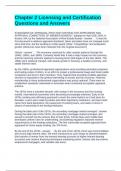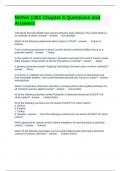Chapter 2 Licensing and Certification
Questions and Answers
STANDARDS OF APPRAISAL PRACTICE FOR REALTOR APPRAISERS AND
APPRAISAL COMMITTEES OF MEMBER BOARDS", adopted on April 20th 1929, in
Boston, MA, by the National Association of Real Estate Boards - answer It was the
first document to address appraisal standards. Basic principles have not changed much
since that time, but the wording is a little quaint. [Note: "misspellings" and antiquated
gender references have been retained from the original document.]
History - answer The economy continued its roller coaster patterns through the
1940s, 1950s, and 1960s. Certainly World War II had a major impact on the economy,
and the returning veterans sparked a housing boom that began in the late 1940s. The
1950s were relatively tranquil, with steady growth in housing, a healthy economy, and
stable interest rates.
By the 1960s, professional appraisal organizations were providing education programs
and touting codes of ethics, in an effort to project a professional image and foster public
recognition and trust in their members. They realized that providing credible appraisal
services is important to the general well-being of society and the economy. However,
membership in these professional organizations was purely optional. There were no
established standards nationwide to articulate what constituted acceptable appraisal
practice.
The 1970s were a turbulent decade, with swings in the economy and the housing
market. International economies were becoming increasingly entwined. Early in the
1970s, lending was still being practiced in much the same fashion as it had been for
decades. Loans were made by banks and other depository institutions, and loan funds
came from bank depositors, the repayment of existing loans, and sales of stock or
shares of ownership in the lending institution.
During the latter part of the 1970s, the secondary mortgage market emerged - answer
During the latter part of the 1970s, the secondary mortgage market emerged, and
served to smooth out the uneven flow of loan funds. Fannie Mae and Freddie Mac
developed uniform rules for underwriting, and banking regulators imposed reserve
requirements on the lending institutions. The first universally-accepted appraisal form
appeared for home equity lending, the 704 Form.
By the end of the 1970s - answer By the end of the 1970s, there was record inflation
and record high interest rates. We were introduced to such things as disintermediation
(the transfer of money from low interest-bearing accounts to higher interest-bearing
accounts) and creative financing techniques employing points, interest rate buy-downs,
wraparound mortgages, and variable rate loans.
, Historical Interest Rates - answer At the beginning of the 1970s, mortgage interest
rates were about 8%. In 1980, the average fixed rate mortgage was 13.77%. In 1981
and 1982, the average mortgage interest rate peaked at 16.64% and 16.09%
respectively. By 1985, the average mortgage rate dropped to 12.12% and it decreased
to 10.18% in 1986. Mortgage borrowing increased significantly during this time, as
property owners were happy to refinance their 15% and 16% mortgages down to
approximately 10%.
Mortgage rates stayed in a narrow range for the next 4 years and were still at 10.13% in
1990.
The 1980s - answer The mid-1980s was a time of continued turbulence for the real
property industry. Housing starts soared from 1,292,000 in 1980 to 1,806,000 in 1986.
Then they tapered off for the rest of the decade.
Sales of existing homes surged from 2,973,000 in 1980 to 3,474,000 in 1986.
Appraisers were extremely busy, and there were no generally-accepted standards for
appraiser performance and ethics. Underwriting standards were lax, particularly with
commercial lending. This situation culminated with the "Savings and Loan Crisis" in the
mid- to late-1980s.
U.S. Representative Douglas Barnard reported the following to Congress in 1986:
"Faulty and fraudulent real estate appraisals have become an increasingly serious
national problem.....They have seriously damaged and contributed directly to the
insolvency of hundreds of the Nation's financial institutions.......Appraiser ineptitude,
negligence and misconduct are widespread.......Accurate, reliable appraisals are
essential to loan underwriting and to the public's perception of the confidence in the
Nation's real estate, finance, and mortgage insurance and investment industries."
The Development of Appraisal Standards - answer In 1986, eight U.S.-based
professional organizations plus one from Canada formed the Ad Hoc Committee on
Uniform Standards to develop appraisal standards. Their initial work focused on
developing a common definition of "market value," since we didn't even have that in the
industry.
The committee realized that to gain public recognition of these standards, it would be
necessary to form a new, independent organization that would place the public's benefit
ahead of that of any individual or group. In 1987, the eight major U.S. appraisal
organizations established The Appraisal Foundation.
It was realized that providing credible appraisal services is necessary to the general
economic well-being of society. This would also provide a sense of trust in professional
appraisal practice.






